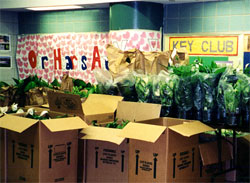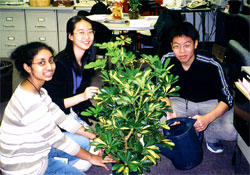Plants Against Adversity
Air Date: Week of January 18, 2002
Student essay winner Leah Rabinowitz tells Living on Earth host Steve Curwood how plant donations helped turn her school – located just blocks from Ground Zero – into a friendly and healthier environment.
Transcript
CURWOOD: Stuyvesant High is located just a few blocks from Ground Zero in Lower Manhattan. In the wake of the collapse of the World Trade Center towers, tests inside the school found contaminated dust and poor air quality. After a one million dollar clean-up and extensive testing, the school re-opened in mid-October. But students soon complained of odors and of rashes, headaches, and respiratory problems.
Then, Stuyvesant officials heard of NASA research which showed that certain plants, such as the Peace Lily and rubber plants, could clean indoor air. The plants absorb pollutants into their leaves and transmit toxins to their roots, where microbes transform them into nutrients for the plant.
Responding to a call for help, a group of Florida nursery growers sent about a thousand plants to Stuyvesant High. The results: students started feeling better. And the plants became a daily reminder, not only of the nation's support but, of the cycle of life.
 Fourteen Florida nurseries donated about
Fourteen Florida nurseries donated about1,000 plants to Stuyvesant H.S.
(Photo: Courtesy of Plants at Work)
The group, Plants at Work, held an essay contest so Stuyvesant students could voice how the plants had helped them. Eleventh grader Leah Rabinowitz won the competition and she joins us now.
CURWOOD: Welcome, Leah, and congratulations.
RABINOWITZ: Thank you very much.
CURWOOD: Well, first off, let's go back to October, a month after the 9-11 attack. What was it like to go back to Stuyvesant after being displaced to another school?
RABINOWITZ: It was certainly difficult. I mean, there were a lot of fears, not only about air quality. Just about being so close to a scene that was so emotional to a lot of people. Just going back there and seeing some of those things so changed was very difficult. But eventually we, you know, settled in, and it just became part of the daily routine again, of just going to school and just partially-- you know, some of the time you don't even realize where you are. You just think, "Well, I'm in school." And then you kind of look out the window and you realize where you are, and it's just a very-- a very emotional thing when you finally make that realization every once in awhile.
CURWOOD: How did you find out about the plant donations?
RABINOWITZ: I walked into school one day, and I saw about 100 plants or so, sitting on a big table. And I was, like, "What's up? What's going on?" And then they told us that every homeroom is going to get a nice, bushy plant to go put on the radiator, and to just make the room a little bit livelier, and I thought it was just a really great donation to our school and to our community.
CURWOOD: Leah, in your essay, which you entitled "A Greener Stuyvesant"-- it's an awfully wonderful writing job, I must say--
RABINOWITZ: Well, thank you.
CURWOOD: -- and I'm wondering if you would mind reading it for us now?
RABINOWITZ: Oh sure, no problem.
"A Greener Stuyvesant."
For the past few weeks, my fellow classmates and I have received several generous donations: from banners of support, to personalized letters, to free notebooks. But the most impacting gift, both physically and symbolically, has been the addition of lively green plants to every homeroom. They have had an impact far larger than I ever could have envisioned.
The plants hold a great deal of symbolism in their outreaching leaves and limbs.
Although we have been back at Stuyvesant for over two months, things have never felt the same. I realize that we can never go back to the way things used to be, that we simply have to learn to adapt to the ever-changing world around us. The plants represent the new lives that we have embarked on, encouraging us to press onward. In addition, they denote a sense of security that we all lost in one way or another on September 11th. Ever since we returned, questions have been raised about the air quality, both in and surrounding the school. The plants help to comfort some of my fears. They stand for a sense of safety, reminding us that life can still flourish, even under these extremely trying conditions.
In addition to symbolic effects, the plants have had a physical effect on my daily life.
For a little over a week before the plants arrived, my throat was hurting so badly that I could barely speak, and I had been getting frequent headaches. But two days after the arrival of the plants, the pain in my throat went away and the intensity of my headaches subsided significantly. The plants, as we were told they would, increased the oxygen level throughout the school, helping to make the air cleaner. In doing so, they also ridded me of my ailment.
 Plant Parents at Stuyvesant H.S. care and feed the plants.
Plant Parents at Stuyvesant H.S. care and feed the plants.(Photo: Courtesy of Plants at Work)
Additionally, my classmates and I have developed a symbiotic relationship of sorts with the plants. I have often helped my friend Cindy water the plants in our homeroom. Although the job entailed taking on additional responsibilities, I felt that it was the least I could do. After all, they had done so much for me. I am proud to see them thriving, making the building seem a little less like a school, not to mention a school in the middle of a virtual war zone.
Every time our academic community received another generous contribution, I felt a sense of gratitude. But when I walked into Stuyvesant a few weeks ago and saw the rows upon rows of plants sitting on a table, waiting to be distributed, I was deeply touched. Words cannot begin to describe my profound appreciation for your kindness. Thank you for your sympathy. Thank you for making the days pass just a little bit faster. Thank you for making every day at Stuyvesant just a little bit brighter and a little bit greener. Thank you so much.
[MUSIC UP AND UNDER - Natalie Merchant "Thank You" Ophelia]
CURWOOD: Leah Rabinowitz is a junior at Stuyvesant High School in New York City and winner of "The Plants Against Adversity" essay contest. And by the way, Living on Earth has compiled a list of ten house plants that can help you clean your air. To find them, log onto our website at www.loe.org.
[MUSIC CONTINUES]
Links
Living on Earth wants to hear from you!
Living on Earth
62 Calef Highway, Suite 212
Lee, NH 03861
Telephone: 617-287-4121
E-mail: comments@loe.org
Newsletter [Click here]
Donate to Living on Earth!
Living on Earth is an independent media program and relies entirely on contributions from listeners and institutions supporting public service. Please donate now to preserve an independent environmental voice.
NewsletterLiving on Earth offers a weekly delivery of the show's rundown to your mailbox. Sign up for our newsletter today!
 Sailors For The Sea: Be the change you want to sea.
Sailors For The Sea: Be the change you want to sea.
 The Grantham Foundation for the Protection of the Environment: Committed to protecting and improving the health of the global environment.
The Grantham Foundation for the Protection of the Environment: Committed to protecting and improving the health of the global environment.
 Contribute to Living on Earth and receive, as our gift to you, an archival print of one of Mark Seth Lender's extraordinary wildlife photographs. Follow the link to see Mark's current collection of photographs.
Contribute to Living on Earth and receive, as our gift to you, an archival print of one of Mark Seth Lender's extraordinary wildlife photographs. Follow the link to see Mark's current collection of photographs.
 Buy a signed copy of Mark Seth Lender's book Smeagull the Seagull & support Living on Earth
Buy a signed copy of Mark Seth Lender's book Smeagull the Seagull & support Living on Earth

